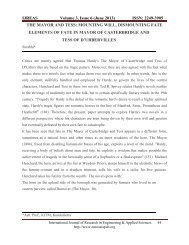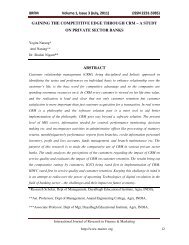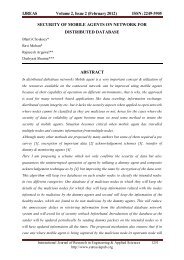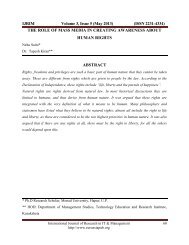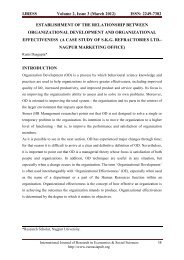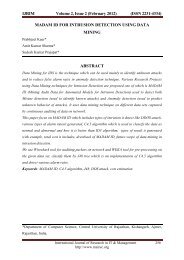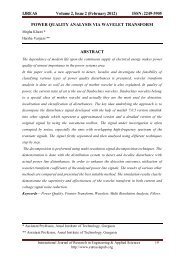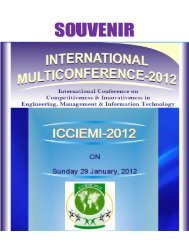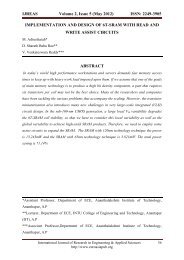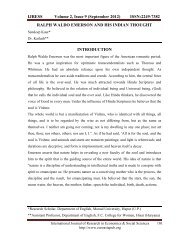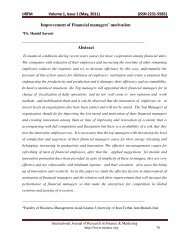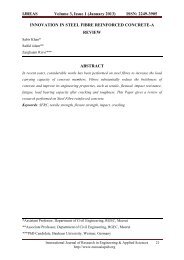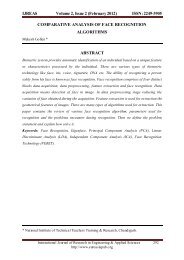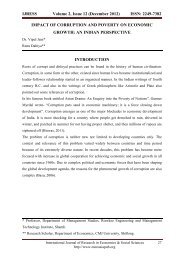a study of selected dividend mutual fund schemes ... - Euroasiapub.org
a study of selected dividend mutual fund schemes ... - Euroasiapub.org
a study of selected dividend mutual fund schemes ... - Euroasiapub.org
Create successful ePaper yourself
Turn your PDF publications into a flip-book with our unique Google optimized e-Paper software.
IJRESS Volume 2, Issue 6 (June 2012) ISSN: 2249-7382<br />
A STUDY OF SELECTED DIVIDEND MUTUAL FUND SCHEMES<br />
WITH JENSON’S ALPHA MODEL<br />
Dr. Sandeep Bansal*<br />
Sanjeev Kumar**<br />
Dr. Surender Kumar Gupta***<br />
Sachin Singla****<br />
ABSTRACT<br />
Mutual <strong>fund</strong> industry in India has shown significant growth and alternative investment option<br />
for global investors in recent years. These <strong>mutual</strong> <strong>fund</strong>s <strong>of</strong>fered a number <strong>of</strong> <strong>dividend</strong> <strong>mutual</strong><br />
<strong>fund</strong> <strong>schemes</strong>. In this present paper we apply a risk-adjusted measure known as Jensen's<br />
Alpha Model on ten randomly <strong>selected</strong> <strong>dividend</strong> <strong>mutual</strong> <strong>fund</strong> <strong>schemes</strong> that estimates how<br />
much a manager's forecasting ability contributes to the <strong>fund</strong>'s returns. We use a sample <strong>of</strong> 10<br />
<strong>mutual</strong> <strong>fund</strong> <strong>schemes</strong> (<strong>dividend</strong>) for the period <strong>of</strong> 4 years from May 2005 to April 2009 on<br />
monthly basis and calculated their NAV. Jensen's Model measure involves a comparison <strong>of</strong><br />
the returns that the <strong>fund</strong> had generated with the returns expected from the <strong>fund</strong> with the given<br />
level <strong>of</strong> its systematic risk (Beta). The difference between two returns is called alpha. We find<br />
that 70% <strong>of</strong> <strong>selected</strong> <strong>mutual</strong> <strong>fund</strong> <strong>schemes</strong> have been performed negatively because having<br />
negative Alpha, and only three out <strong>of</strong> ten <strong>selected</strong> <strong>dividend</strong> <strong>mutual</strong> <strong>fund</strong> <strong>schemes</strong> got the<br />
positive value <strong>of</strong> Alpha.<br />
Keywords: Mutual Fund Performance, Jensen's Model, Alpha, Average Return, Systematic<br />
Risk.<br />
*Assistant Pr<strong>of</strong>essor, Indira Gandhi National College, Ladwa<br />
**Faculty <strong>of</strong> Management, SRM Global, Ambala.<br />
***Associate Pr<strong>of</strong>essor, Maharaja Agrasen Institute <strong>of</strong> Management and Technology<br />
Jagadhri.<br />
****Lecturer in Commerce, MLN College, Radaur<br />
International Journal <strong>of</strong> Research in Economics & Social Sciences 37<br />
http://www.euroasiapub.<strong>org</strong>
IJRESS Volume 2, Issue 6 (June 2012) ISSN: 2249-7382<br />
INTRODUCTION<br />
Mutual <strong>fund</strong>s are mobilizing savings, particularly from the small and household investors, for<br />
investments in stock and money market. Basically, these institutions have pr<strong>of</strong>essional <strong>fund</strong><br />
managers, capable <strong>of</strong> managing <strong>fund</strong>s very prudently and pr<strong>of</strong>itably <strong>of</strong> individuals and<br />
institutions that may not have such high degree <strong>of</strong> expertise or may not have adequate time to<br />
cope with the complexities <strong>of</strong> different investment avenues, legal provisions associated<br />
therewith and vagaries and vicissitudes <strong>of</strong> capital markets. Mutual <strong>fund</strong>s, thus, provide an<br />
alternative to the investors, who instead <strong>of</strong> making direct investments in shares or bonds<br />
through public issues or through secondary market subscribe to the corpus <strong>of</strong> <strong>mutual</strong> <strong>fund</strong>s.<br />
Investors can reap all the benefits <strong>of</strong> good investment through <strong>mutual</strong> <strong>fund</strong>s like enjoying<br />
growth in those scrips in which he might not have otherwise invested, holding a balanced and<br />
well-diversified portfolio, better returns due to specialized and pr<strong>of</strong>essional management <strong>of</strong><br />
<strong>fund</strong>s etc.<br />
Mutual <strong>fund</strong>s raise <strong>fund</strong>s by selling their own shares also known as units. When an investor<br />
owns shares in <strong>mutual</strong> <strong>fund</strong>s he owns a proportional share <strong>of</strong> their securities portfolio. In<br />
other words, share <strong>of</strong> a <strong>mutual</strong> <strong>fund</strong> actually represents a part share in many securities that it<br />
has purchased. Mutual <strong>fund</strong> share certificate combines the convenience and satisfaction <strong>of</strong><br />
owning shares in many industries.<br />
Thus, <strong>mutual</strong> <strong>fund</strong>s are investment intermediaries, which pool investors’ <strong>fund</strong>s, acquiring<br />
individual investments, and pass on the returns there<strong>of</strong> to the investors, Besides Investment<br />
business, <strong>mutual</strong> <strong>fund</strong>s may also undertake, if permitted, underwriting and other merchant<br />
banking activities.<br />
In India Mutual Fund concept took roots only in sixties, after a century old history elsewhere<br />
in the world. Realizing the needs for a more active mobilization <strong>of</strong> household savings to<br />
provide investible resources to industry, the idea <strong>of</strong> first <strong>mutual</strong> <strong>fund</strong> in India was born out <strong>of</strong><br />
the far sighted vision <strong>of</strong> Sri T. Krishnamachari the then Finance Minister. He wrote to the<br />
then Prime Minister Pandit Jawahar Lal Nehru outlining the need for an institution which<br />
would serve as a conduit for these resources to the Indian Capital market, and RBI was<br />
entrusted to create this special Institution. While introducing Unit Trust <strong>of</strong> India (UTI) Bill in<br />
Parliament Sri Krishnamachari observed, “I would christen this attempt as an adventure in<br />
small saving and I am confident that we are embarking on this adventure with every hope <strong>of</strong><br />
being successful”. He highlighted UTI as “an opportunity for the middle and lower Income<br />
groups to acquire without much difficulty property in the form <strong>of</strong> shares. UTI, in 1964 started<br />
International Journal <strong>of</strong> Research in Economics & Social Sciences 38<br />
http://www.euroasiapub.<strong>org</strong>
IJRESS Volume 2, Issue 6 (June 2012) ISSN: 2249-7382<br />
with a unit scheme popular as US-64.<br />
RBI Guidelines<br />
1. Mutual Fund should be constituted as a trust under the Indian Trust Act and at least two<br />
outside trustees should be there.<br />
2. Mutual Fund should have a full time executive for the day-to-day management.<br />
3. There must be an arm's length relationship between the <strong>mutual</strong> <strong>fund</strong> and the sponsor<br />
bank.<br />
4. Every sponsor bank should contribute at least Rs. 25 lakh.<br />
5. A clear statement <strong>of</strong> objectives and policies for the <strong>fund</strong> must be laid down and published.<br />
6. Operations must be restricted to capital market instruments only, and <strong>mutual</strong> <strong>fund</strong>s are not<br />
to undertake direct or indirect lending. Underwriting, bills discounting and money market<br />
operations (Subsequently public sector <strong>mutual</strong> <strong>fund</strong>s were allowed to undertake money<br />
market operations).<br />
7. Restrictions must be placed on the cost <strong>of</strong> managing any scheme.<br />
8. A Management Information System (MIS) should be evolved to maintain data and to<br />
submit various reports.<br />
Ministry <strong>of</strong> Finance issued a new set <strong>of</strong> guidelines to give a healthy outfit for <strong>mutual</strong><br />
<strong>fund</strong> functioning. These guidelines issued on 28 th June 1990 were applicable only to <strong>mutual</strong><br />
<strong>fund</strong> <strong>schemes</strong> operating in the country.<br />
REVIEW OF LITERATURE<br />
Review <strong>of</strong> previous studies provides the need and justification for the research work to be<br />
undertaken, and research methodology explains the research process. Researcher and<br />
practitioners have produced literature covering different aspects <strong>of</strong> <strong>mutual</strong> <strong>fund</strong>s. A variety <strong>of</strong><br />
technical and quantitative measures have been developed to assess and compare the financial<br />
performance <strong>of</strong> <strong>mutual</strong> <strong>fund</strong> <strong>schemes</strong> as well as the performance <strong>of</strong> <strong>fund</strong>s managers. These<br />
measures provide the methods <strong>of</strong> comparing risk-adjusted returns <strong>of</strong> a portfolio with other<br />
portfolios or with benchmarks.<br />
1. Wermers (2000) in his <strong>study</strong> used two databases in the analysis <strong>of</strong> <strong>mutual</strong> <strong>fund</strong> returns. The<br />
first database contains quarterly portfolio holding for all US equity <strong>mutual</strong> <strong>fund</strong>s existing at<br />
any time between January 1975 and December 1994. The second <strong>mutual</strong> <strong>fund</strong> database is<br />
available from CRSP and used by Carhart (1997). The <strong>study</strong> found that <strong>fund</strong>s which hold<br />
stocks outperform the market by 1.3 % per year, but their returns under-perform by 1 %. Of<br />
the 2.3 % difference between these results, 0.7% is due to the underperformance <strong>of</strong> non- stock<br />
International Journal <strong>of</strong> Research in Economics & Social Sciences 39<br />
http://www.euroasiapub.<strong>org</strong>
IJRESS Volume 2, Issue 6 (June 2012) ISSN: 2249-7382<br />
holdings, whereas 1.6% is due to expenses and transaction costs. Thus, the <strong>fund</strong>s pick stocks<br />
well enough to cover their costs.<br />
2. Mishra, et al., (2002) measured <strong>mutual</strong> <strong>fund</strong> performance using lower partial moment.<br />
In this paper, measures <strong>of</strong> evaluating portfolio performance based on lower partial moment<br />
are developed. Risk from the lower partial moment is measured by taking into account only<br />
those stocks in which return is below a pre-specified “target rate” like risk-free rate.<br />
3. Rajeeva Sinha and Vijay Jog(2003) the authors examine the performance <strong>of</strong> Canadian<br />
<strong>mutual</strong> <strong>fund</strong> managers, and find that their performance is lackluster when com-pared with<br />
some well-recognized bench marks such as the TSE 300 and the 90-day T-Bill rates, and is<br />
even lower when one accounts for the timing <strong>of</strong> entry and exit by <strong>mutual</strong> <strong>fund</strong> investors. They<br />
attribute this to the lack <strong>of</strong> performance persistence. However, unlike some US studies, they<br />
do not find evidence suggesting that Canadian <strong>mutual</strong> <strong>fund</strong> investors chase winners, and<br />
are reluctant to exit from losing <strong>fund</strong>s; while investors do allocate <strong>fund</strong>s based on past<br />
performance, the allocations do not favor star <strong>fund</strong>s disproportionately. Poor performers<br />
experience significant <strong>fund</strong> withdrawals. They attribute this to the differences in the tax<br />
treatment <strong>of</strong> retirement-related savings – the principal source <strong>of</strong> <strong>mutual</strong> <strong>fund</strong>s asset growth.<br />
4. Kshama Fernandes (2003) evaluated index <strong>fund</strong> implementation in India. In this paper,<br />
tracking error <strong>of</strong> index <strong>fund</strong>s in India is measured. The consistency and level <strong>of</strong> tracking<br />
errors obtained by some well-run index <strong>fund</strong> suggest that it is possible to attain low levels <strong>of</strong><br />
tracking error under Indian conditions. At the same time, there do seem to be periods when<br />
certain index <strong>fund</strong>s appear to depart from the discipline <strong>of</strong> indexation.<br />
5. Warren Bailey, Haitao Li, and Xiaoyan Zhang *(2004) analyze hedge <strong>fund</strong> performance,<br />
using the stochastic discount factor (SDF) approach and imposing the arbitrage-free<br />
requirement to correctly value the derivatives and dynamic trading strategies used by hedge<br />
<strong>fund</strong>s. Using SDFs <strong>of</strong> many asset-pricing models, we evaluate hedge <strong>fund</strong> portfolios based on<br />
style and characteristics. Without the arbitrage-free requirement, pricing errors are relatively<br />
small and a few models can explain hedge <strong>fund</strong> returns. With this requirement, pricing errors<br />
are much bigger, and all models fail to price style and volatility portfolios. Fund manager<br />
characteristics like age, experience, and education explain some <strong>of</strong> the mis-pricing <strong>of</strong> our best<br />
risk model.<br />
OBJECTIVE OF THE STUDY<br />
The present <strong>study</strong> focuses on the performance evaluation <strong>of</strong> <strong>dividend</strong> based <strong>mutual</strong> <strong>fund</strong><br />
<strong>schemes</strong> <strong>of</strong> various <strong>mutual</strong> <strong>fund</strong>s operating in the country. The specific objective <strong>of</strong> the <strong>study</strong> is<br />
International Journal <strong>of</strong> Research in Economics & Social Sciences 40<br />
http://www.euroasiapub.<strong>org</strong>
IJRESS Volume 2, Issue 6 (June 2012) ISSN: 2249-7382<br />
to find out the performance <strong>of</strong> <strong>selected</strong> <strong>dividend</strong> <strong>mutual</strong> <strong>fund</strong>s <strong>schemes</strong> by applying Jensen's<br />
Alpha Model. The <strong>study</strong> also ranks the <strong>selected</strong> <strong>mutual</strong> <strong>fund</strong> <strong>schemes</strong> according to their risk<br />
and return.<br />
RESEARCH METHODOLOGY<br />
Return alone should not be considered the basis <strong>of</strong> measurement <strong>of</strong> performance <strong>of</strong> a <strong>mutual</strong><br />
<strong>fund</strong> <strong>schemes</strong>, it should also include level <strong>of</strong> risk undertaken and diversification <strong>of</strong> <strong>fund</strong>s. The<br />
excess <strong>of</strong> portfolio return, over the risk less return is an indication <strong>of</strong> the overall portfolio<br />
performance.<br />
The <strong>study</strong> is entirely based on the secondary data. The scope <strong>of</strong> the <strong>study</strong> is kept limited to the<br />
time period <strong>of</strong> 4 years (May 2005 to April 2009). The sample consists <strong>of</strong> 10 <strong>dividend</strong> based<br />
<strong>mutual</strong> <strong>fund</strong> <strong>schemes</strong>, which are chosen at random basis. It is important to point out that NAVs<br />
have been taken on monthly basis. The data regarding the NAV’s and return <strong>of</strong> these 10 <strong>mutual</strong><br />
<strong>fund</strong> <strong>schemes</strong> have been collected from SEBI annual reports and “www.amfiindia.com”. The<br />
BSE Sensex was used as the proxy for market index and each scheme has been evaluated with<br />
respect to this benchmark. The <strong>study</strong> considered interest rate on treasury bills as risk-less return<br />
in view <strong>of</strong> the average yield being 5 percent during the <strong>study</strong> period.<br />
NET ASSET VALUE<br />
NAV has been obtained from the different sources such as:<br />
1. AMFIINDIA<br />
2. Alpha<br />
The portfolio return calculated on the basis <strong>of</strong> NAV does not consider any change in the market<br />
price but considers the change in the net asset value <strong>of</strong> <strong>mutual</strong> <strong>fund</strong>s units during the period.<br />
Portfolio’s return (Rn) is calculated by using the following formula:<br />
R<br />
P<br />
=<br />
( NAV<br />
t<br />
− NAV<br />
NAV<br />
t − 1 t<br />
+<br />
t −1<br />
) D<br />
C<br />
t<br />
R p = Portfolio return<br />
NAV t = Net asset value in time period t<br />
NAV t-1 = Net asset value in the period t-l<br />
D t = <strong>dividend</strong> in the form <strong>of</strong> bonus distributed in the period t<br />
C t = cash <strong>dividend</strong> distributed in the time period t<br />
Month-wise returns have been calculated for all <strong>mutual</strong> <strong>fund</strong>s’ <strong>schemes</strong> during the <strong>study</strong><br />
period. The portfolio return Rp was computed in the manner prescribed above on a monthly<br />
International Journal <strong>of</strong> Research in Economics & Social Sciences 41<br />
http://www.euroasiapub.<strong>org</strong>
IJRESS Volume 2, Issue 6 (June 2012) ISSN: 2249-7382<br />
basis. The holding period return has been computed with the process <strong>of</strong> geometric mean <strong>of</strong><br />
monthly NAV based returns. The formula for the geometric mean has been used as follows:<br />
Holding period return (HPR) =<br />
[{ R<br />
pt + 1<br />
+ R<br />
p t + 2<br />
+ ......... R<br />
p t + n<br />
}]<br />
The same procedure is adopted to calculate the benchmark portfolio return.<br />
Jensen Model<br />
Jensen model is a risk adjusted performance measure. This measure is developed by Michael<br />
Jensen and is sometimes referred to as the differential return method. This measure involves<br />
evaluation <strong>of</strong> the returns that the <strong>fund</strong> had generated with the returns actually expected <strong>of</strong> the<br />
<strong>fund</strong>, given the level <strong>of</strong> its systematic risk. The difference between two returns is called<br />
alpha, which measures the performance <strong>of</strong> a <strong>fund</strong> in relation to the expected over the period.<br />
Required return <strong>of</strong> a <strong>fund</strong> at a given level <strong>of</strong> risk can be calculated as:<br />
E (R p ) = R F + β (R M - R p )<br />
E(R P ) = The expected return on security or portfolio<br />
R F = Risk free rate <strong>of</strong> return<br />
Beta = Systematic risk <strong>of</strong> the portfolio<br />
R M = Average market return during the period<br />
R P = Return <strong>of</strong> the portfolio<br />
After calculating it, alpha can be obtained by subtracting required return from the actual<br />
return <strong>of</strong> the <strong>fund</strong>. Symbolically it can be represented as:<br />
α = R p - E (R p )<br />
R p = Return <strong>of</strong> the portfolio<br />
E (R p ) = The expected return on security or portfolio<br />
σ = Jensen alpha value<br />
Return and Risk Coefficient <strong>of</strong> Various Sample Schemes<br />
Fund Schemes Return σ β Alpha Rank<br />
Birla Sun Life Basic Inds.<br />
Fund(Dividend) 0.0017 0.1061 0.9942 -0.426<br />
8<br />
Franklin India Blue-chip<br />
Fund(Dividend) 0.0083 0.0947 1.0126 -0.427<br />
9<br />
H D F C Liquid Fund(Dividend) 0.0002 0.0032 -0.006 0.0029 2<br />
Kotak Gilt(Investment Plan<br />
Regular Plan Dividend) 0.0071 0.0237 -0.002 0.0097<br />
3<br />
International Journal <strong>of</strong> Research in Economics & Social Sciences 42<br />
http://www.euroasiapub.<strong>org</strong>
IJRESS Volume 2, Issue 6 (June 2012) ISSN: 2249-7382<br />
L & T Gilt Fund (Investment<br />
Dividend-Q) 0.0021 0.0264 -0.073 0.0334<br />
1<br />
L I C M F Balanced<br />
Fund(Dividend) 0.0015 0.0796 0.8044 -0.294<br />
5<br />
Reliance Growth Fund<br />
(Dividend) 0.0053 0.0978 0.959 -0.407<br />
7<br />
S B I Magnum Gilt Fund<br />
(Dividend) 0.0015 0.0233 0.0284 -0.011<br />
10<br />
Tata Balanced Fund (Dividend) 0.0158 0.073 0.6948 -0.307 6<br />
Templeton India Pension Plan<br />
(Treasury Dividend) -0.001 0.0465 0.3758 -0.163<br />
4<br />
BSE Sensex 0.0135 0.0836 1<br />
CONCLUSION<br />
Higher alpha represents superior performance <strong>of</strong> the <strong>fund</strong> and lower alpha represents<br />
unfavorable performance <strong>of</strong> the <strong>fund</strong>. Limitation <strong>of</strong> this model is that it considers only<br />
systematic risk not the entire risk associated with the <strong>fund</strong> and an ordinary investor cannot<br />
mitigate unsystematic risk, as his knowledge <strong>of</strong> market is primitive. The table above shows<br />
the average value was found to be -0.19. The result shows alpha L & T Gilt Fund (Investment<br />
Dividend-Q), H D F C Liquid Fund (Dividend) having positive value that indicates the superior<br />
performance among the <strong>dividend</strong> <strong>fund</strong>s to the market performance, while the value <strong>of</strong> alpha<br />
in this case <strong>of</strong> SBI Magnum Gilt Fund (Dividend) and Franklin India Blue-chip Fund(Dividend) is<br />
negative which is indicative <strong>of</strong> the dismal performance <strong>of</strong> these <strong>schemes</strong>.As compared to the<br />
average value <strong>of</strong> Jensen Index <strong>of</strong> sampled <strong>schemes</strong> with the market index, 70 percent (7 out<br />
<strong>of</strong> 10) <strong>schemes</strong> have performed lesser, and have shown least risk-adjusted performance The<br />
performance <strong>of</strong> 7 <strong>mutual</strong> <strong>fund</strong> <strong>schemes</strong> is undoubtedly disappointing & dismal which could<br />
give a shattering & jolt to investors’ faith in the <strong>mutual</strong> <strong>fund</strong> <strong>schemes</strong>. But Jenson’s Alpha <strong>of</strong><br />
three <strong>schemes</strong> namely L & T Gilt Fund (Investment Dividend-Q), H D F C Liquid Fund (Dividend)<br />
and Kotak Gilt (Investment Plan Regular Plan Dividend) have positive value during the <strong>study</strong><br />
period indicating their superior performance among <strong>selected</strong> <strong>mutual</strong> <strong>fund</strong> <strong>schemes</strong>.<br />
REFERENCES<br />
1. Haldane , Andrew G (2009), “Why banks failed the stress test”, Bank <strong>of</strong> England,<br />
w.bank<strong>of</strong>england.co.uk/publications/speeches/2009/speech374.pdf<br />
International Journal <strong>of</strong> Research in Economics & Social Sciences 43<br />
http://www.euroasiapub.<strong>org</strong>
IJRESS Volume 2, Issue 6 (June 2012) ISSN: 2249-7382<br />
2. Jackwerth, J., 2000, “Recovering Risk Aversion from Option Prices and Realized<br />
Returns,”Review <strong>of</strong> Financial Studies 13, 433-451.<br />
3. Jagoinvestor.com, (2008), what is Diversified Portfolio and how to create it [Online]<br />
Available at: http://www.jagoinvestor.com/2008/04/what-is-diversified-portfolio-andhow.html<br />
[viewed on 20th August 2010].<br />
4. Jorion, P., 1995, “Predicting Volatility in the Foreign Exchange Market,” Journal <strong>of</strong><br />
Finance 50, 507-528.<br />
5. Jorion, P., 2000, “Risk Management Lessons from Long-Term Capital<br />
Management,” European Financial Management 6(3), 277-300.<br />
6. Kumar M. (2010), Efficient Market Theory, [Online] Available at:<br />
http://www.scribd.com/doc/32755638/Efficient-Market-Theory [viewed on 2nd<br />
September 2010]<br />
7. Kuritzkes, A. and T. Schuermann (2008), “What we know, don’t know and can’t know<br />
about bank risk: a view from the trenches”,<br />
http://papers.ssrn.com/sol3/papers.cfmabstract_id=887730<br />
8. Lewis, M., 1999, “How the Eggheads Cracked,” New York Times Magazine, January<br />
24, 24-77.<br />
9. Mitchell, M., and T. Pulvino, 2001, Characteristics <strong>of</strong> Risk in Risk Arbitrage,”<br />
Journal <strong>of</strong> Finance 56, 2135-2175.<br />
10. Modigliani, F., and L. Modigliani, 1997, “Risk-Adjusted Performance,” Journal <strong>of</strong><br />
Portfolio Manage- ment 23 (2), 45-54.<br />
11. Neuberger, A., 1994, “The Log Contract: A New Instrument to Hedge Volatility,”<br />
Journal <strong>of</strong> Portfolio Management, winter, 74-80.<br />
12. Pan, J., 2002, “The Jump-Risk Premia Implicit in Options: Evidence from an<br />
Integrated TimeSeries Study,” Journal <strong>of</strong> Financial Economics 63, 3-50.<br />
13. Peskin, M., M. Urias, S. Anjilvel, and B. Boudreau, 2000, “Why Hedge Funds Make<br />
Sense,”<br />
14. Quanti- tative Strategies, Global Equity and Derivative Markets, M<strong>org</strong>an Stanley<br />
Dean Witter.<br />
15. Satyha Swaroop Debashish, volume 2, issue (2) 2009, “Options and Effciency,” KCA<br />
Journal <strong>of</strong> Business Management.<br />
16. Tripathy, NP and Sahu, PK., “ Mutual Fund in India; A Financial Service in Capital<br />
Mraket, Finance India, Vol. X, No. 1, March 1996, pp. 85-91.<br />
International Journal <strong>of</strong> Research in Economics & Social Sciences 44<br />
http://www.euroasiapub.<strong>org</strong>
IJRESS Volume 2, Issue 6 (June 2012) ISSN: 2249-7382<br />
17. Varma, J R (1999) “Rupee-Dollar Option Pricing and Risk Measurement: Jump<br />
Processes, Changing Volatility and Kurtosis Shifts”, Journal <strong>of</strong> Foreign Exchange and<br />
International Finance, 1391), 11-33<br />
18. Warther, Vincent A., “Aggregate Mutual Fund Flows and Security Returns, Journal<br />
<strong>of</strong> financal Economies, Vol. 39, Feb. 1995, pp. 209-235.<br />
19. Wermers, Russ., “Mutual Fund Performance: An Empirical Decomposition into Stock<br />
Pricing Talent, Style, Transactions Costs, and Expenses, Journal <strong>of</strong> Finance, Vol. 55,<br />
no 4, August 2000, pp. 1655-1695.<br />
International Journal <strong>of</strong> Research in Economics & Social Sciences 45<br />
http://www.euroasiapub.<strong>org</strong>



